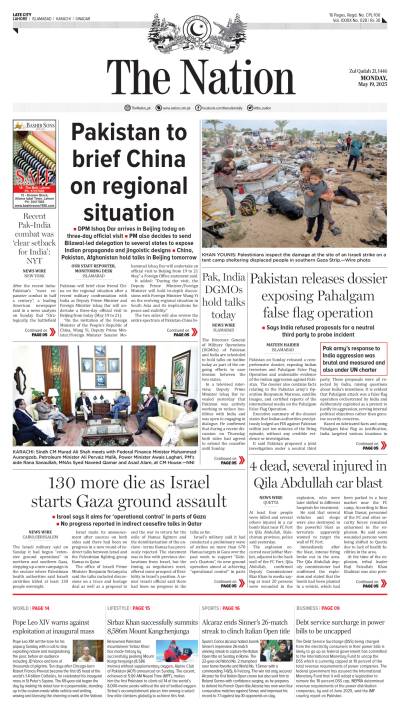LAHORE - As the rise in global temperature burns forests down in North America and cause extreme weather events, many countries around the world are feeling the weight of climate change. Pakistan, present in the heart of South Asia, is one of these many nations faced by the threat of a future marked by melting glaciers, rising sea levels and parched fields. So far, Pakistan’s struggle with climate change is not merely a series of meteorological intense weather events, but a convoluted web of political, social, economic and environmental crises. From cloud piercing mountains in the North, the fertile plains of Punjab, sun-baked deserts of Thar and Cholistan, to the smooth sandy beaches of Karachi and Gawadar, challenges induced by climate change are wreaking havoc on both the landscape and the livelihoods of millions. Climate change is reshaping Pakistan’s future, examining the science behind these changes, the economic costs, and the urgent calls for adaptive policies. South Asia has emerged as the world’s epicenter of climate vulnerability observing its devastating effects. Pakistan is among the countries most vulnerable to climate variation despite contributing less than 1% to global greenhouse gas emissions. A major reason for this misfortune is its geological position, surrounded by high-altitude snow covered mountain and glaciers up north, and the warm Arabian Sea in the south. The country has observed a surge in aggravated weather events, including catastrophic floods, terrible heatwaves, intense monsoon rains. In 2022, unrestrained rainfall brought floods that drowned one-third of the country, effecting 33 million people. There are also major economic and societal implications associated with such circumstances. Statistics show that the floods destroyed two million homes resulting in displacement of 3 million people, and millions of people and livestock got wounded and went missing. The agricultural sector plays a crucial role in Pakistan’s economy, contributing around 25% to the national GDP and employing approximately 42% of the labor force. As the largest employer in the country, agriculture also accounts for over 75% of the nation’s export revenue, driven largely by agri-based textiles and food products. Pakistan is one of the leading exporters of textiles and rice globally and is also a significant importer of palm oil for cooking. The impact of climate change is in this sector of Pakistan is especially severe as it heavily depends on water from glacial melt in the northern regions. The recurring cycles of droughts and catastrophic floods have both led to diminished yield of crops, livestock loss, destruction of irrigation system, and food shortage in recent years. The economic toll from the 2022 floods amounted to approximately US $30 billion in losses, with $21 billion loss in the agriculture sector according to the Ministry of Food and Agriculture directly. Four million acres of cultivable land was destroyed causing loss of crops leaving people without access to food and water. Shelter, food and security became a huge risk. Over the long term, climate change has been reflected in declining rainfall patterns and higher rates of glacial melt, which accounts for more than 70% of the country’s river flows. Additionally, the average temperature across Pakistan has risen by 0.5°C over the past three decades. The Climate Change Vulnerability Index predicts an increase in droughts during the winter months, affecting cash crop production, while heavier rainfall in the summer months is expected to cause floods across various regions of the country. Furthermore, glaciers up north pose a significant threat to the country’s water resources increasing risk of avalanches and glacial lake outburst floods across the river systems. Inefficiency in water management such as the lack of sufficient dams result in excess water being discharged into the sea, exacerbating the country’s water scarcity. This will negatively affect vital crops, including wheat and rice, with yields expected to decline nationwide.
These weather conditions are obviously not just limited to Pakistan, but transcend border to India and beyond. As the winter smog blankets our cities from Lahore to Delhi and farmers across Punjab to Bihar face the unpredictability of shifting monsoon patterns, the stark reality of climate change’s transnational nature becomes ever clearer. In the light of these non-traditional security threats, there is a dire need for dialogue, collaboration and research for mutually beneficial solutions that can be advantageous for all involved nations.
In the face such challenges, the government of Pakistan is committed to drive the nation towards a climate-resilience by introducing various climate action policies. The Ministry of Climate Change and Environmental Coordination’s vision for sustainable development and green economic growth aligns with its 5E framework: Exports, Equity, E-Pakistan, Environment, and Energy which reflects in initiatives like URAAN Pakistan. The government has also introduced key policies, such as the National Climate Change Policy (2021), NDC (2021), the National Adaptation Plan (2023), Electric Vehicle Policy, the National Clean Air Policy (2023), and prohibiting single-use plastics (2023) to address environmental challenges and stress policy implementation. Through the Public Sector Development Programme (PSDP), significant climate initiatives have been introduced that focus on water quality, and ecosystem restoration. The Upscaling of the Green Pakistan Programme has planted over 2.2 billion trees, creating millions of green jobs and gaining international recognition. The GLOF-II Project, addressing glacial threats in Gilgit-Baltistan, enhances resilience through early warning systems and infrastructure improvements.
In recent news, Prime Minister Shehbaz Sharif brought up crucial issues at the World Governments Summit in UAE regarding climate change, the importance of climate finance and international cooperation. He emphasized the need for energy security and sustainability highlighting the nations’ pledge to attain 60% renewable energy by 2030. Moreover, he urged global assistance for Pakistan’s green energy transition, estimating a $100 billion investment necessity. In a meeting with UN Country Team in Pakistan, the Prime Minister reiterated Pakistan’s commitment to combating climate change, stressing the importance of climate financing and stronger partnerships for sustainable development. He also called for reforms in global financial institutions to better represent developing countries.
Pakistan is also committed to reducing hazardous waste and plastic pollution, with phase-wise bans on single-use plastics and stricter enforcement. In a historic move, the country introduced its National Carbon Market Policy (2024), advancing toward a low-carbon, climate-resilient economy. By mobilizing domestic and international finance, including through its Green Taxonomy and Climate Finance Strategy, the nation aims to strengthen its climate governance, ensuring transparent reporting and compliance with international agreements such as the Montreal Protocol. Through these comprehensive initiatives, the state is committed to secure a sustainable, resilient future for its communities while advancing climate justice.
2025 marks a pivotal year for Pakistan, offering new openings to integrate economic and climate priorities. As several initiatives initiated in the previous year near completion, Pakistan faces the challenge of addressing both its economic and climate vulnerabilities concurrently, recognizing their interdependence. The nation will work to align its Nationally Determined Contributions (NDC) and sectoral policies with its five-year plans, reinforcing its commitment to climate action. This year presents an opportunity to bridge the credibility gap by ensuring effective implementation of climate policies and honoring commitments under international climate agreements. Lastly, strengthening local governments (LGs) is crucial for community-level climate resilience. Empowered LGs are essential to creating sustainable economic growth that engages marginalized groups, youth, and women. By prioritizing climate-resilient development investments and viewing all finance as climate finance, Pakistan can make significant strides in building a resilient future.






